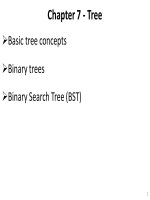Data Structures and Algorithms - Chapter 8: Heaps pptx
Bạn đang xem bản rút gọn của tài liệu. Xem và tải ngay bản đầy đủ của tài liệu tại đây (550.24 KB, 41 trang )
Chapter 8 - Heaps
Binary Heap. Min-heap. Max-heap.
Efficient implementation of heap ADT: use of array
Basic heap algorithms: ReheapUp, ReheapDown, Insert Heap,
Delete Heap, Built Heap
d-heaps
Heap Applications:
Select Algorithm
Priority Queues
Heap sort
Advanced implementations of heaps: use of pointers
Leftist heap
Skew heap
Binomial queues
1
Binary Heaps
DEFINITION: A max-heap is a binary tree
structure with the following properties:
• The tree is complete or nearly complete.
• The key value of each node is greater than
or equal to the key value
2
DEFINITION: A min-heap is a binary tree
structure with the following properties:
• The tree is complete or nearly complete.
• The key value of each node is less than or
equal to the key value in each of its
descendents.
all<=K
all<=K
K
all>=K
all>=K
K
max-heap
min-heap
Properties of Binary Heaps
Structure property of heaps
Key value order of heaps
3
Properties of Binary Heaps
Structure property of heaps:
• A complete or nearly complete binary tree.
• If the height is h, the number of nodes n is between
2
h-1
and (2
h
-1)
• Complete tree: n = 2
h
-1 when last level is full.
• Nearly complete: All nodes in the last level are on the left.
• h = |log
2
n| + 1
• Can be represented in an array and no pointers are necessary.
4
Properties of Binary Heaps
Key value order of max-heap:
(max-heap is often called as heap)
5
Basic heap algorithms
ReheapUp: repairs a "broken" heap by floating the last
element up the tree until it is in its correct location.
6
Basic heap algorithms
ReheapDown: repairs a "broken" heap by pushing the root of
the subtree down until it is in its correct location.
7
Contiguous Implementation of Heaps
0
1
2
3
4
5
6
A
B
C
D
E
F
G
8
Conceptual
Physical
Heap
data <Array of <DataType> >
count <int> //number of elements in heap
End Heap
2i+1
2i+2
i
|(i-1)/2|
ReheapUp
Algorithm ReheapUp (val position <int>)
Reestablishes heap by moving data in position up to its correct location.
Pre All data in the heap above this position satisfy key value order of a heap,
except the data in position.
Post Data in position has been moved up to its correct location.
Uses Recursive function ReheapUp.
1. if (position <> 0) // the parent of position exists.
1. parent = (position-1)/2
2. if (data[position].key > data[parent].key)
1. swap(position, parent) // swap data at position with data at parent.
2. ReheapUp(parent)
2. return
End ReheapUp
9
ReheapDown
Algorithm ReheapDown (val position <int>, val lastPosition <int>)
Reestablishes heap by moving data in position down to its correct location.
Pre All data in the subtree of position satisfy key value order of a heap, except the
data in position.
Post Data in position has been moved down to its correct location.
Uses Recursive function ReheapDown.
1. leftChild = position *2 + 1
2. rightChild = position *2 + 2
3. if ( leftChild <= lastPosition ) // the left child of position exists.
1. if ( rightChild <= lastPosition) AND ( data[rightChild].key > data[leftChild].key )
1. child = rightChild
2. else
1. child = leftChild // choose larger child to compare with data in position
3. if ( data[child].key > data[position].key )
1. swap(child, position) // swap data at position with data at child.
2. ReheapDown(child, lastPosition)
4. return
End ReheapDown
10
Insert new element into min-heap
The new element is put to the last position, and ReheapUp is called for
that position.
11
Insert 14:
14
14
14
<ErrorCode> InsertHeap (val DataIn <DataType>) // Recursive version.
Inserts new data into the min-heap.
Post DataIn has been inserted into the heap and the heap order property
is maintained.
Return overflow or success
Uses recursive function ReheapUp.
1. if (heap is full)
1. return overflow
2. else
1. data[count ] = DataIn
2. ReheapUp(count )
3. count = count + 1
4. return success
End InsertHeap
12
<ErrorCode> InsertHeap (val DataIn <DataType>) // Iterative version
Inserts new data into the min-heap.
Post DataIn has been inserted into the heap and the heap order property
is maintained.
Return overflow or success
1. if (heap is full)
1. return overflow
2. else
1. current_position = count - 1
2. loop (the parent of the element at the current_position is exists) AND
(parent.key > DataIn .key)
1. data[current_position] = parent
2. current_position = position of parent
3. data[current_position] = DataIn
4. count = count + 1
5. return success
End InsertHeap
13
Delete minimum element from min-heap
14
The element in the last position is put to the position of the root, and
ReheapDown is called for that position.
31
31
31
31
Delete minimum element from min-heap
15
The element in the last position is put to the position of the root, and
ReheapDown is called for that position.
31
<ErrorCode> DeleteHeap (ref MinData <DataType>) // Recursive version
Removes the minimum element from the min-heap.
Post MinData receives the minimum data in the heap and this data
has been removed. The heap has been rearranged.
Return underflow or success
Uses recursive function ReheapDown.
1. if (heap is empty)
1. return underflow
2. else
1. MinData = Data[0]
2. Data[0] = Data[count -1]
3. count = count - 1
4. ReheapDown(0, count -1)
5. return success
End DeleteHeap
16
<ErrorCode> DeleteHeap (ref MinData <DataType>) // Iterative version
Removes the minimum element from the min-heap.
Post MinData receives the minimum data in the heap and this data
has been removed. The heap has been rearranged.
Return underflow or success
1. if (heap is empty)
1. return underflow
2. else
1. MinData = Data[0]
2. lastElement = Data[count – 1] // The number of elements in the
// heap is decreased so the last
// element must be moved
// somewhere in the heap.
17
// DeleteHeap(cont.) // Iterative version
3. current_position = 0
4. continue = TRUE
5. loop (the element at the current_position has children) AND
(continue = TRUE)
1. Let child is the smaller of two children
2. if (lastElement.key > child.key )
1. Data[current_position] = child
2. current_position = current_position of child
3. else
1. continue = FALSE
6. Data[current_position] = lastElement
7. count = count - 1
8. return success
End DeleteHeap
18
Build heap
<ErrorCode> BuildHeap (val listOfData <List>)
Builds a heap from data from listOfData.
Pre listOfData contains data need to be inserted into an empty heap.
Post Heap has been built.
Return overflow or success
Uses Recursive function ReheapUp.
1. count = 0
2. loop (heap is not full) AND (more data in listOfData)
1. listOfData.Retrieve(count, newData)
2. data[count] = newData
3. ReheapUp( count)
4. count = count + 1
3. if (count < listOfData.Size() )
1. return overflow
4. else
1. return success
End BuildHeap
19
Build heap
Algorithm BuildHeap2 ()
Builds a heap from an array of random data.
Pre Array of count random data.
Post Array of data becames a heap.
Uses Recursive function ReheapDown.
1. position = count / 2 -1
2. loop (position >=0)
1. ReheapDown(position, count-1)
2. position = position - 1
3. return
End BuildHeap2
20
Complexity of Binary Heap Operations
21
d-heaps
d-heap is a simple generalization of a binary heap.
In d-heap, all nodes have d children.
d-heap improve the running time of InsertElement to O(log
d
n).
For large d, DeleteMin operation is more expensive: the minimum of
d children must be found, which takes d-1 comparisons.
The multiplications and divisions to find children and parents are
now by d, which increases the running time. (If d=2, use of the bit
shift is faster).
d-heap is suitable for the applications where the number of Insertion
is greater than the number of DeleteMin.
22
Heap Applications
Select Algorithms.
Priority Queues.
Heap sort (we will see in the Sorting Chapter).
23
Select Algorithms
Determine the k
th
largest element in an unsorted list
Algorithm 1a:
• Read the elements into an array, sort them.
• Return the appropriate element.
The running time of a simple sorting algorithm is O(n
2
)
24
Select Algorithms
Determine the k
th
largest element in an unsorted list
Algorithm 1b:
• Read k elements into an array, sort them.
• The smallest of these is in the k
th
position.
• Process the remaining elements one by one.
• Compare the coming element with the k
th
element in
the array.
• If the coming element is large, the k
th
element is
removed, the new element is placed in the correct
place.
The running time is O(n
2
)
25









